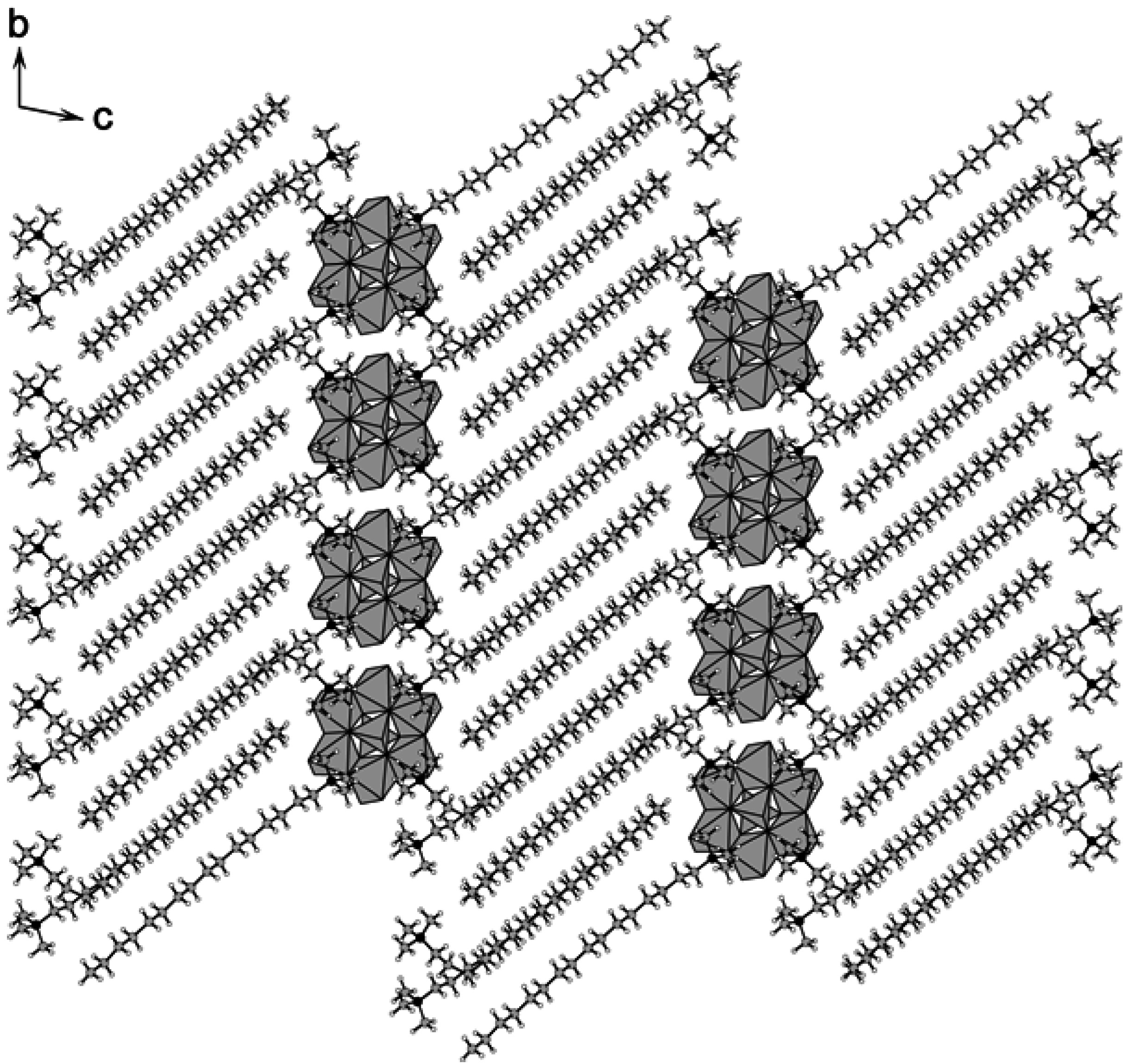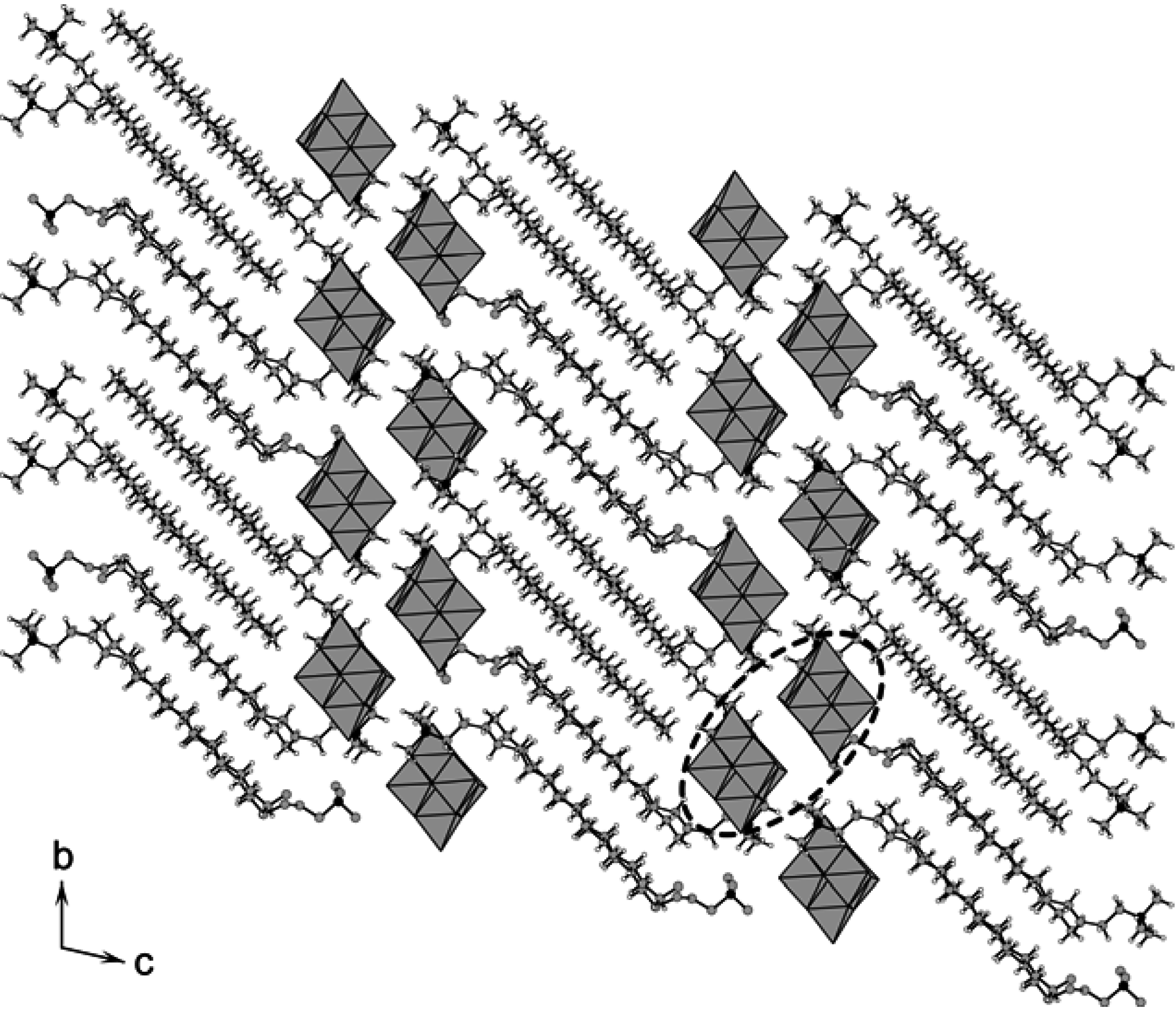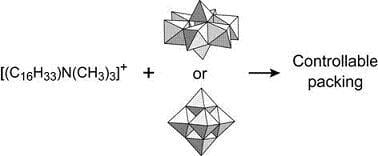Controllable Layered Structures in Polyoxomolybdate-Surfactant Hybrid Crystals
Abstract
:1. Introduction
2. Results and Discussion


| 1 | 2 | |
|---|---|---|
| Chemical formula | C76H168N4Mo8O26 | C38H84N2Mo6O19 |
| Formula weight | 2321.66 | 1448.71 |
| Crystal system | triclinic | triclinic |
| Space group | P (No.2) | P (No.2) |
| a (Å) | 9.958(8) | 9.911(8) |
| b (Å) | 11.149(3) | 22.34(3) |
| c (Å) | 24.95(2) | 25.58(3) |
| α (°) | 98.06(4) | 102.78(4) |
| β (°) | 94.828(7) | 99.12(3) |
| γ (°) | 115.66(4) | 91.19(4) |
| V (Å3) | 2439(3) | 5444(10) |
| Z | 1 | 4 |
| ρcalcd (g cm-3) | 1.580 | 1.768 |
| T (K) | 173 | 173 |
| μ(Mo Kα) (mm-1) | 1.062 | 1.407 |
| No. of reflections measured | 21313 | 48956 |
| No. of independent reflections | 10383 | 22835 |
| No. of parameters | 515 | 594 |
| R1 (I > 2σ(I)) | 0.0513 | 0.0642 |
| wR2 (all data) | 0.0921 | 0.1748 |
3. Experimental
3.1. Syntheses
3.2. Crystallography
4. Conclusions
Acknowledgements
References
- Aruchamy, A. (Ed.) Photoelectrochemistry and Photovoltaics of Layered Semiconductors; Kluwer: Dordrecht, The Netherlands, 1992.
- Cava, R.J. Contemporary superconducting materials. Chem. Commun. 2005, 5373–5377. [Google Scholar] [CrossRef]
- Intercalation Chemistry; Whittingham, M.S.; Jacobson, A.J. (Eds.) Academic Press: New York, NY, USA, 1982.
- Brühwiler, D.; Calzaferri, G. Molecular sieves as host materials for supramolecular organization. Microporous Mesoporous Mater. 2004, 72, 1–23. [Google Scholar] [CrossRef]
- Ouahab, L. Organic/inorganic supramolecular assemblies and synergy between physical properties. Chem. Mater. 1997, 9, 1909–1926. [Google Scholar] [CrossRef]
- Coronado, E.; Gómez-García, C.J. Polyoxometalate-based molecular materials. Chem. Rev. 1998, 98, 273–296. [Google Scholar] [CrossRef] [PubMed]
- Huo, Q.; Margolese, D.I.; Ciesla, U.; Demuth, D.G.; Feng, P.; Gier, T.E.; Sieger, P.; Firouzi, A.; Chmelka, B.F.; Schüth, F.; Stucky, G.D. Organization of organic molecules with inorganic molecular species into nanocomposite biphase arrays. Chem. Mater. 1994, 6, 1176–1191. [Google Scholar] [CrossRef]
- Yamauchi, Y.; Kuroda, K. Rational design of mesoporous metals and related nanomaterials by a soft-template approach. Chem. Asian J. 2008, 3, 664–676. [Google Scholar] [CrossRef]
- Hill, C.L. Polyoxometalates. Chem. Rev. 1998, 98, 1–390. [Google Scholar] [CrossRef] [PubMed]
- Long, D.-L.; Burkholder, E.; Cronin, L. Polyoxometalate clusters, nanostructures and materials: From self assembly to designer materials and devices. Chem. Soc. Rev. 2007, 36, 105–121. [Google Scholar] [CrossRef] [PubMed]
- Michailovski, A.; Patzke, G.R. Hydrothermal synthesis of molybdenum oxide based materials: Strategy and structural chemistry. Chem. Eur. J. 2006, 12, 9122–9134. [Google Scholar] [CrossRef] [PubMed]
- Stein, A.; Fendorf, M.; Jarvie, T.P.; Mueller, K.T.; Benesi, A.J.; Mallouk, T.E. Salt-gel synthesis of porous transition-metal oxides. Chem. Mater. 1995, 7, 304–313. [Google Scholar] [CrossRef]
- Janauer, G.G.; Dobley, A.; Guo, J.; Zavalij, P.; Whittingham, M.S. Novel tungsten, molybdenum, and vanadium oxides containing surfactant ions. Chem. Mater. 1996, 8, 2096–2101. [Google Scholar] [CrossRef]
- Taguchi, A.; Abe, T.; Iwamoto, M. Non-silica-based mesostructured materials: Hexagonally mesostructured array of surfactant micelles and 11-tungstophosphoric heteropoly anions. Adv. Mater. 1998, 10, 667–669. [Google Scholar] [CrossRef]
- Do, J.; Jacobson, A.J. Mesostructured lamellar phases containing six-membered vanadium borophosphate cluster anions. Chem. Mater. 2001, 13, 2436–2440. [Google Scholar] [CrossRef]
- Polarz, S.; Smarsly, B.; Antonietti, M. Colloidal organization and clusters: Self-assembly of polyoxometalate-surfactant complexes towards three-dimensional organized structures. ChemPhysChem 2001, 7, 457–461. [Google Scholar] [CrossRef]
- Zhang, G.; Ke, H.; He, T.; Xiao, D.; Chen, Z.; Yang, W.; Yao, J. Synthesis and characterization of new layered polyoxometallates–1,10-decanediamine intercalative nanocomposites. J. Mater. Res. 2004, 19, 496–500. [Google Scholar] [CrossRef]
- Janauer, G.G.; Dobley, A.D.; Zavalij, P.Y.; Whittingham, M.S. Evidence for decavanadate clusters in the lamellar surfactant ion phase. Chem. Mater. 1997, 9, 647–649. [Google Scholar] [CrossRef]
- Fosse, N.; Brohan, L. Thermal and structural investigations of the bis-dihexadecyldimethylammonium dichromate. J. Solid State Chem. 1999, 145, 655–667. [Google Scholar] [CrossRef]
- Ito, T.; Sawada, K.; Yamase, T. Crystal structure of bis(dimethyldioctadecylammonium) hexamolybdate: A molecular model of Langmuir–Blodgett films. Chem. Lett. 2003, 32, 938–939. [Google Scholar] [CrossRef]
- Ito, T.; Yamase, T. Inorganic-organic hybrid layered crystal composed of polyoxomolybdate and surfactant with π electrons. Chem. Lett. 2009, 38, 370–371. [Google Scholar] [CrossRef]
- Nyman, M.; Ingersoll, D.; Singh, S.; Bonhomme, F.; Alam, T.M.; Brinker, C.J.; Rodriguez, M.A. Comparative study of inorganic cluster-surfactant arrays. Chem. Mater. 2005, 17, 2885–2895. [Google Scholar] [CrossRef]
- Nyman, M.; Rodriguez, M.A.; Anderson, T.M.; Ingersoll, D. Two structures toward understanding evolution from surfactant-polyoxometalate lamellae to surfactant-encapsulated polyoxometalates. Cryst. Growth Des. 2009, 9, 3590–3597. [Google Scholar] [CrossRef]
- Hur, N.H.; Klemperer, W.G.; Wang, R.-C. Tetrabutylammonium hexamolybdate(VI). Inorg. Synth. 1990, 27, 77–78. [Google Scholar]
- Desiraju, G.R. The C-H···O hydrogen bond: Structural implications and supramolecular design. Acc. Chem. Res. 1996, 29, 441–449. [Google Scholar] [CrossRef] [PubMed]
- Steiner, T. Unrolling the hydrogen bond properties of C–H···O interactions. Chem. Commun. 1997, 727–734. [Google Scholar] [CrossRef]
- Chiba, H.; Wada, A.; Ozeki, T. Cation-controlled assembly of Na+-linked lacunary α-Keggin tungstosilicates. Dalton Trans. 2006, 1213–1217. [Google Scholar] [CrossRef]
- Xu, B.; Peng, Z.; Wei, Y.; Powell, D.R. Polyoxometalates covalently bonded with terpyridine ligands. Chem. Commun. 2003, 2562–2563. [Google Scholar] [CrossRef]
- Xia, Y.; Wu, P.; Wei, Y.; Wang, Y.; Guo, H. Synthesis, crystal structure, and optical properties of a polyoxometalate-based inorganic-organic hybrid solid, (n-Bu4N)2[Mo6O17(≡NAr)2] (Ar = o-CH3OC6H4). Cryst. Growth Des. 2006, 6, 253–257. [Google Scholar] [CrossRef]
- Li, T.; Lü, J.; Gao, S.; Li, F.; Cao, R. Inorganic-organic hybrid with 3D supramolecular channel assembled through C–H···O interactions based on the decavanadate. Chem. Lett. 2007, 36, 356–357. [Google Scholar] [CrossRef]
- Sheldrick, G.M. SHELX-97; University of Göttingen: Göttingen, Germany, 1997. [Google Scholar]
- CrystalStructure 3.8; Rigaku/MSC: The Woodlands, TX, USA, 2006.
© 2010 by the authors. Licensee Molecular Diversity Preservation International, Basel, Switzerland. This article is an open-access article distributed under the terms and conditions of the Creative Commons Attribution license ( http://creativecommons.org/licenses/by/3.0/).
Share and Cite
Ito, T.; Yamase, T. Controllable Layered Structures in Polyoxomolybdate-Surfactant Hybrid Crystals. Materials 2010, 3, 158-164. https://doi.org/10.3390/ma3010158
Ito T, Yamase T. Controllable Layered Structures in Polyoxomolybdate-Surfactant Hybrid Crystals. Materials. 2010; 3(1):158-164. https://doi.org/10.3390/ma3010158
Chicago/Turabian StyleIto, Takeru, and Toshihiro Yamase. 2010. "Controllable Layered Structures in Polyoxomolybdate-Surfactant Hybrid Crystals" Materials 3, no. 1: 158-164. https://doi.org/10.3390/ma3010158






